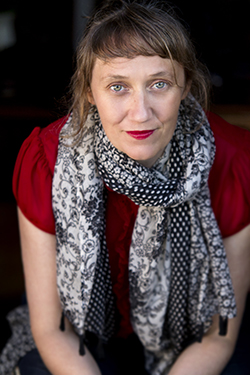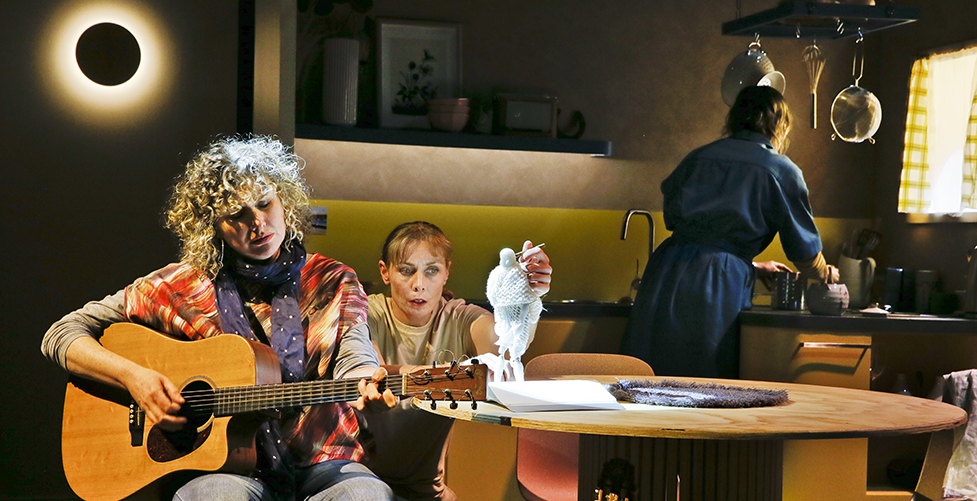
Taking the Waters
Q&A with Sarah Kriegler
Sarah Kriegler is an award-winning director, puppeteer, writer and co-director of Lemony S Puppet Theatre. Her magical new work Taking the Waters has been acclaimed by critics and audiences alike since its premiere in November last year. We caught up with Sarah to discover more about the story and inspiration behind the show, ahead of its Centre debut this April.
What is the story behind Taking the Waters?
Sarah Kriegler (SK): Taking the Waters follows the story of three sisters: Chook, Maggie and Duck. Duck, the youngest is dying. The two older sisters have returned after many years apart, to care for their dying sister. What happens in the world of the sisters is probably very recognisable to anyone who has a slightly fraught relationship with family (and is there anyone who doesn’t?). The three sisters fall back into long-ago established patterns of behaviour which does none of them justice – Chook, the oldest sister, becomes the fussy chook, bustling around looking after everyone, never resting, never taking care of herself; Maggie, the middle sister, becomes a slovenly adolescent, strumming on the guitar and singing, getting in the way; and Duck, even as she lays in her sick bed, slots back into the role of the peacemaker. But slowly, as life slips away, things have to change, new patterns have to be established and a new way of being together has to be found.

How would you describe Taking the Waters to new audiences?
SK: We describe this work as a ‘requiem for the carer’ as everything in this work is scored – the lights, the movement of objects, the puppetry and of course, Suzannah’s singing. What we have made is like a visual piece of music or perhaps a visual poem and that is something out of the ordinary. It is very beautiful, meditative, moving, sad and often, surprisingly, quite funny.
The subject matter is pretty unexpected. We hear and see a lot of work about death and dying but never told from the perspective of the carer. Being a carer is often a thankless task; whether it’s caring for tiny children, someone who’s ill or an elderly family member; but if we didn’t have people in our community who were prepared to do this for others, things would become uncivilised very quickly. We wanted to make a work that honoured this experience, that expressed the horror, the difficulties and the joy of it.
What was the motivation to create Taking the Waters?
SK: Well, this is such an interesting question with quite a long answer. I have been friends with Suzannah Espie for many years. We actually did our undergraduate degrees together at La Trobe University in the ‘90s. Over the years, I’ve been to many of her gigs and always been a tremendous fan of her work. Her soulful and extraordinary voice has always moved me deeply. A number of years ago, I kept getting flashes of an image of two women holding a body and while seeing this image, I kept hearing Suzannah’s voice. So, one night after a dinner party, I said to her ‘Suzannah, I keep seeing this image and hearing your voice. Would you be up for collaborating and seeing what we can make of it?’ And, that was the start of Taking the Waters.
However, when we set out, we thought we would make a show about the miracle that is modern medicine. But, as we delved deeper into the material, we kept bumping up against stories and experiences where medicine, despite all its advances, could do nothing but ease physical pain. And so, we began to wonder, in cases like these, where do we turn to instead to receive the care we need to ease us into death? Our families? Our friends? Our memories? Consequently, our questions became: What do we expect of the living as we die? How far do we expect those around us to go to give us a ‘good death’? Difficult questions to ask and even more difficult to answer.
What underpinned these questions was a very personal experience. In 2010, my beloved brother-in-law was diagnosed with Motor Neurone Disease. Upon diagnosis, our family rallied around him to care for him as he died. Taking the Waters is not our story but reflects instead the many conversations we have had since that time with other people about their experiences of caring for the dying.

Taking the Waters combines music, puppets, visual art and theatre. Was it always your intention to fuse these elements into the work, and what inspired this?
SK: Puppetry, as an image-based artform, works best when accompanied by equally strong, resonant music. All of our previous works thus far have had strong collaborations with musicians and composers. Taking the Waters investigates this further and was the first time we worked with live sung voice. Suzannah Espie’s soulful, resonant voice has been the perfect accompaniment to this work. Her voice cracks you open the same way the puppetry does, and the effect is visceral. We have been making puppet works for adults and family audiences for almost 15 years. Sometimes it feels a little simplified to call them ‘puppet works’ as they always include live performance, music, song, objects and some puppetry. It was always our intention to fuse these wonderfully diverse elements together again for Taking the Waters. But our starting place is always with a puppet of some kind. In this case, it was with an almost life-sized human body, which inspired the character of Duck. When we began this work, we knew we wanted a shadow puppetry element to it. Shadow puppetry is a fabulous way of portraying a complex story simply. In 2017, we had the good fortune of meeting Kyoko Imazu and seeing her paper-cut work. We fell in love with Kyoko’s work instantly and asked her to collaborate with us on Taking the Waters. It’s been a match made in heaven as Kyoko’s sensibilities and responses to the stimuli, the story and my friend Suzannah’s voice, were spot on.

What was it like to collaborate with artist Kyoko Imazu and singer-songwriter Susannah Espie?
SK: It has been fabulous to work with the both Suzannah and Kyoko but I’d be remiss if I didn’t also mention the talents of puppeteer Tamara Rewse and actor Fiona Macleod as their contributions to the work have been instrumental too. Also in the room was sound designer Marco Cher-Gibbard, lighting designer Rachel Burke, set and costume designer Yvette Turnball and dramaturg Ben Grant. It has been an immense pleasure working with this incredible group of artists, all from different disciplines, to create this work. There were a lot of tears, a lot of laughs, many visits to the rehearsal rooms from dogs and children and a lot of mint chocolate balls consumed. It was pretty magic actually.
How has the work been received since its premiere?
SK: The work premiered in November at SpeakEasy, presented by Darebin Arts and it has been very favourably received both by critics and audience members. To be honest, we were terrified to be presenting a work on this subject matter but so many people in the audience stayed after the show simply to say ‘thank you’, it was quite overwhelming and very, very beautiful.

